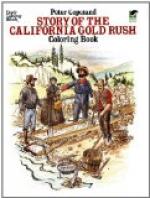Some of the gold in the crushed ore will not mix with the quicksilver, and this is treated to a bath of cyanide, a peculiar acid that melts the gold as water does a lump of sugar. So all of value is saved, and the worthless “tailings” go to the dump. Even the black sands on the ocean beach have gold in them. In the desert also there is gold, which is “dry-washed” by putting the sand into a machine and with a strong blast of air blowing away all but the heavy scales of gold.
Though the Argonauts of ’49 found much wealth in yellow gold, our “Golden State,” on hillsides, in river-beds, or deep down in hidden quartz ledges, still holds great fortunes waiting to be found.
MINING STORIES
A large book might be filled with the stories told by the men who found gold in the early days. Their “lucky strikes” in the “dry-diggings” sound like fairy tales. Imagine turning over a big rock and then picking up pieces of gold enough to half fill a man’s hat from the little nest that rock had been lying in for years and years!
And think of finding forty-three thousand dollars in a yellow lump over a foot long, six inches wide and four inches thick! This was the biggest nugget on record and actually weighed one hundred and ninety-five pounds. The next one, too, you might have been glad to pick up, as it held a hundred and thirty-three pounds of solid gold. Little seventy-five and fifty-pound treasures were common, and a soldier stopping to drink at a roadside stream found a nugget weighing over twenty pounds lying close to his hand.
It paid to get up early those days, also for a man in Sonora, while taking his morning walk, struck his foot against a large stone, and forgot the pain when he saw the stone was nearly all gold. Another man, with good eyes, got a fifty-pound nugget on a trail many people used all the time. One day, after a heavy rain, a man who was leading a mule and cart through a street in Sonora, noticed that the wheel struck a big stone; he stooped to lift it out of the way, and found the stone to be a lump of gold weighing thirty-five pounds. In less than an hour all that part of the town and the street was staked off into mining-claims, but no more was found. One of the largest of these nuggets was found by three or four men, who took it to San Francisco and the Eastern states, and exhibited it for money. They guarded the precious thing day and night, but at last quarrelled so that it had to be broken up and divided between them.
The first piece Marshall found was said to be worth about fifty cents, and the second over five dollars. Almost all, though, that was found was like beans or small seeds or in fine dust. No one tried to weigh or measure such gold more correctly than to call a pinch between the finger and thumb a dollar’s worth, while a teaspoonful was an ounce, or sixteen dollars’ worth. A wineglassful meant a hundred




